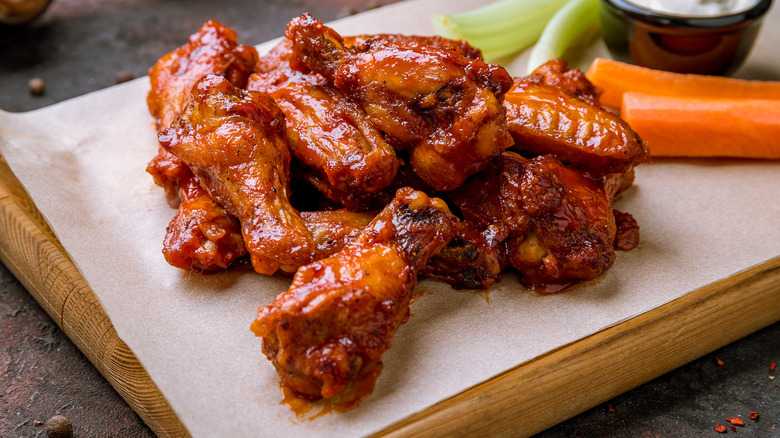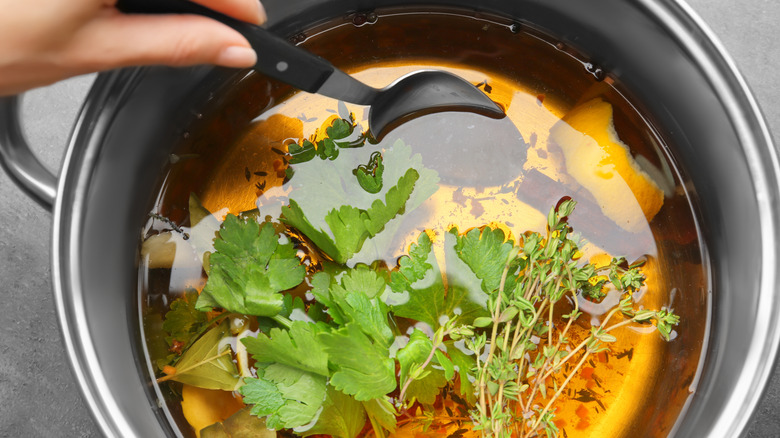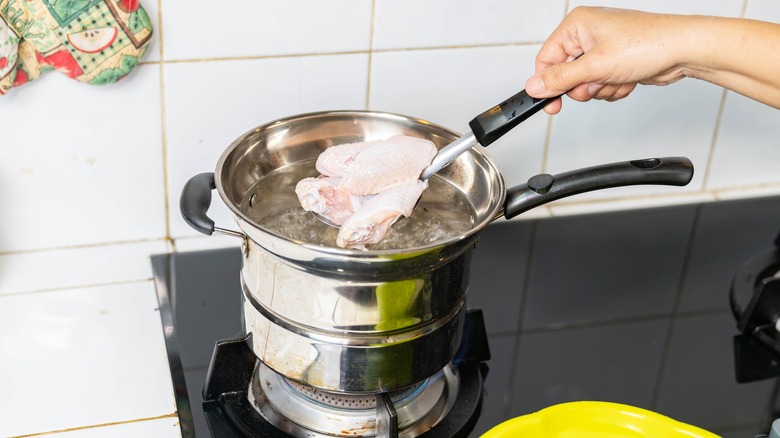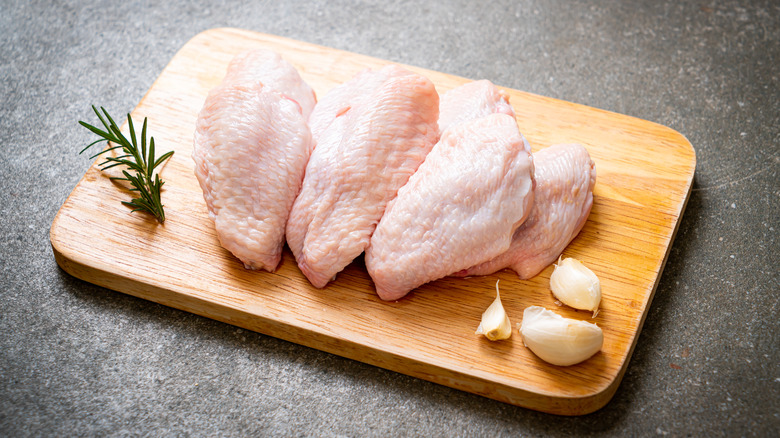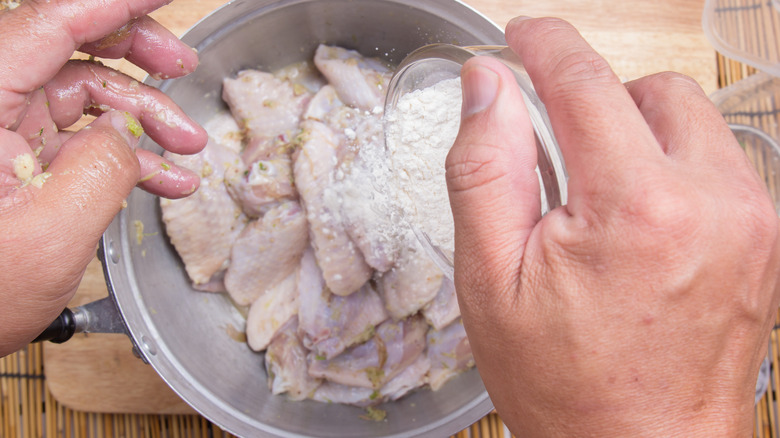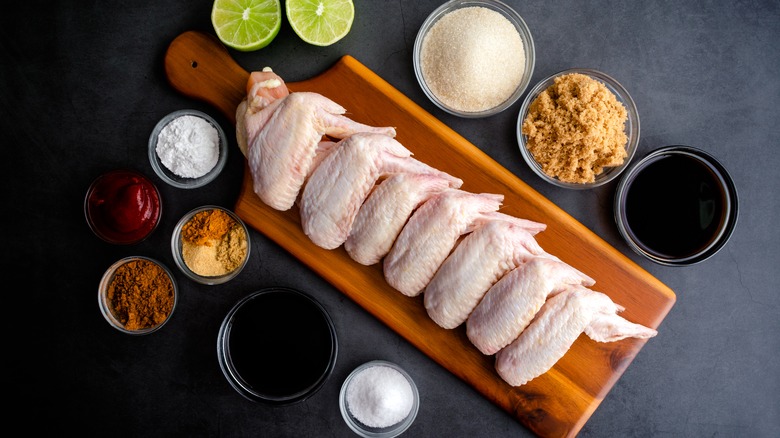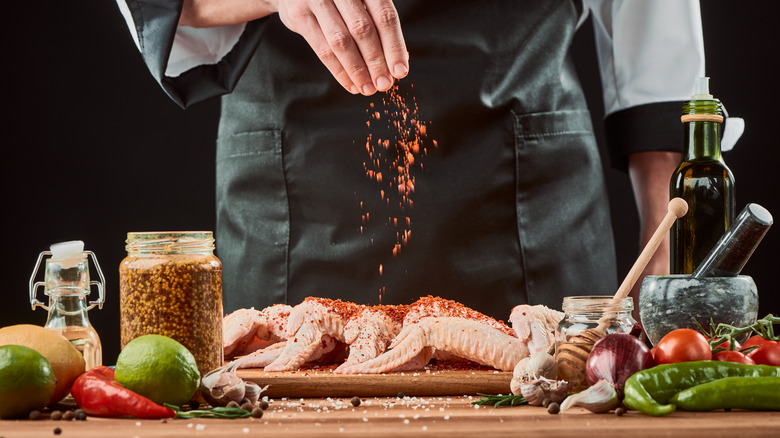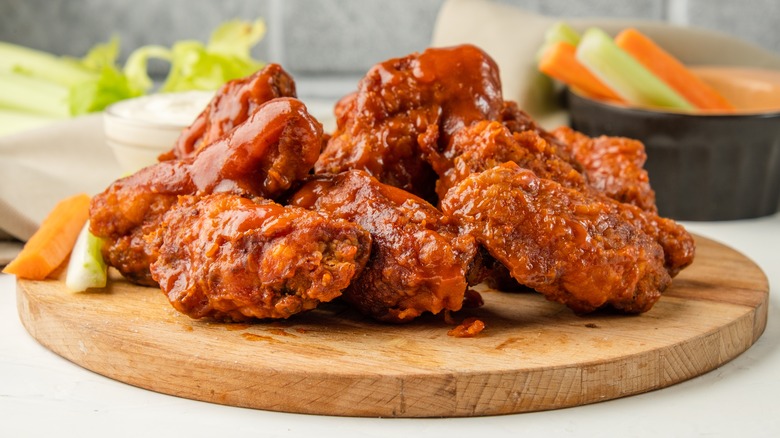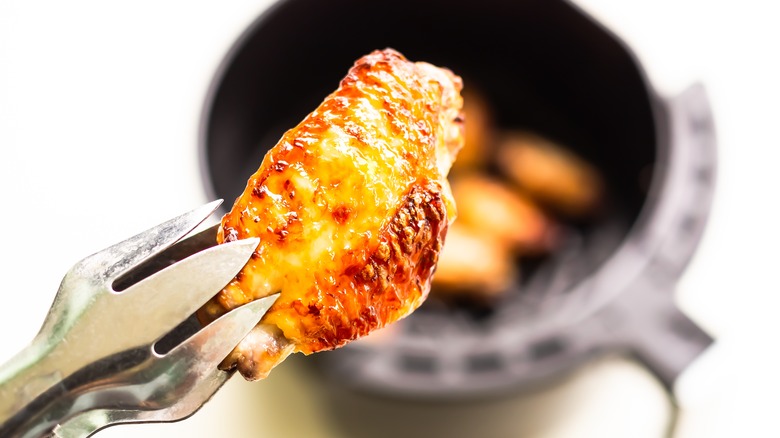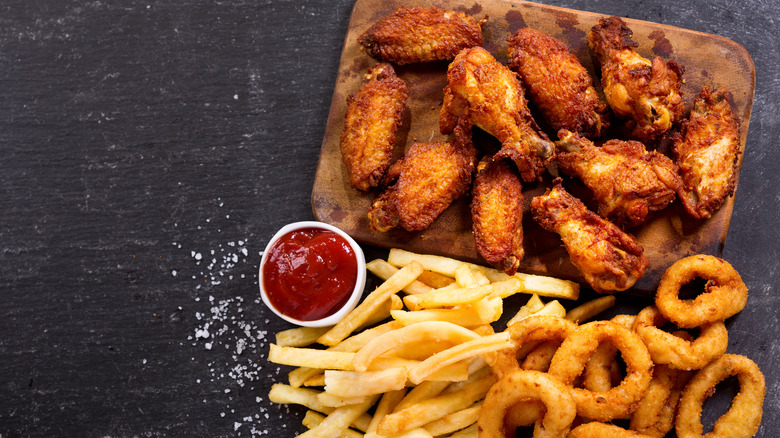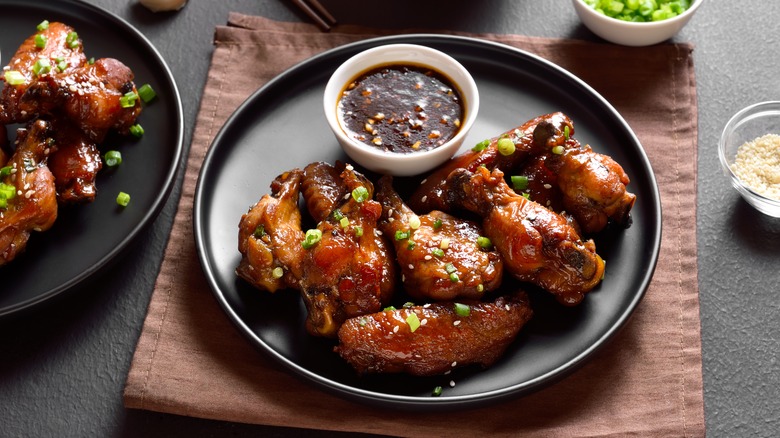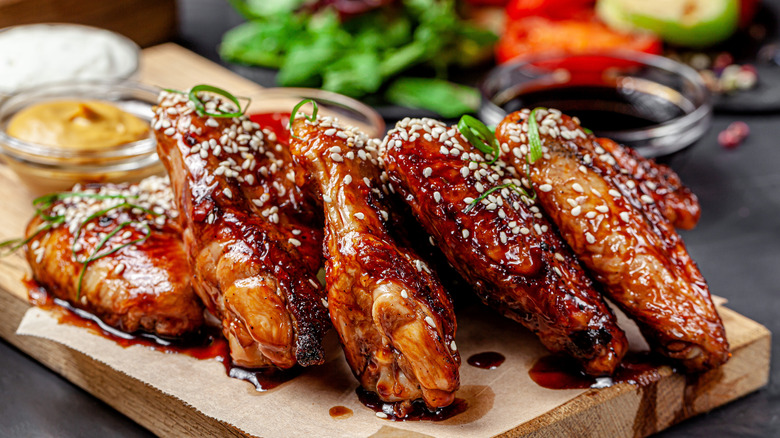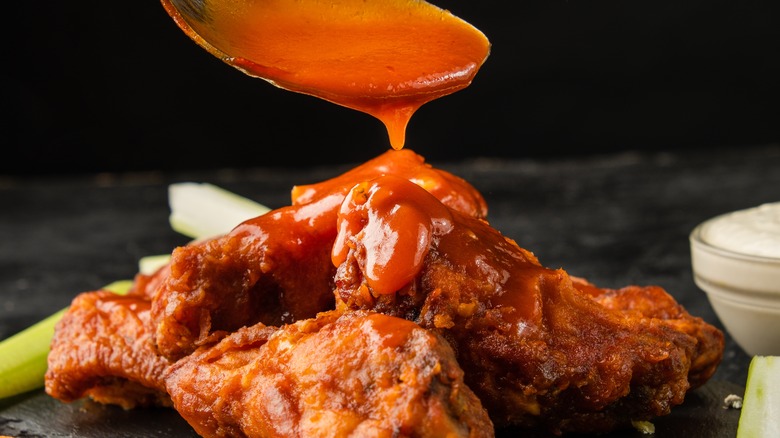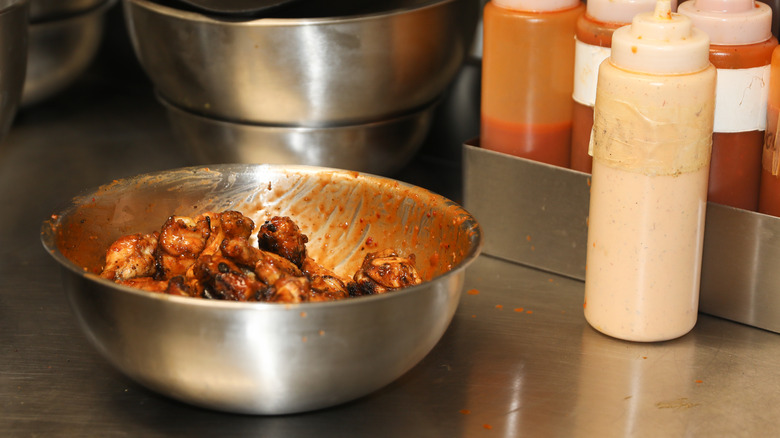13 Hacks For Chicken Wings You'll Wish You Knew Sooner
The ability to cook perfectly crispy, tender, and tasty chicken wings from the comfort of your home is a bit of a culinary flex. Though it may not seem like the case, the common chicken wing is actually a wildly tricky cut to learn how to cook — especially if you want results that at least equal (or exceed) what you can buy at a nearby restaurant.
But before diving into the details, take a moment to imagine what the perfect chicken wing looks like to you — is it the classic crispy and spicy Buffalo wing, served alongside a simple side of blue cheese dip, celery sticks, and an ice cold beer? Or perhaps your ideal wing is covered in green onions and sesame seeds and dripping with a sticky sweet-and-sour sauce and served over rice. The options are endless: garlic and parmesan, mango and habanero, ghost pepper ... even plain wings, when cooked correctly, can pack a powerfully delicious taste as well as texture.
Whatever flavor you prefer, what matters the most when it comes to cooking chicken wings is the technique. So, to help you spread your wings and soar into crispy, sauced-up glory, here are a dozen of the best hacks for making chicken wings at home.
Brine those wings beforehand
One of the world's greatest culinary crimes has to do with brine — more specifically, how delicious, easy, and effective brine is compared to how darn infrequently it is utilized in day-to-day home cooking. And though brining is a technique that has been tragically typecast in a supporting role to Thanksgiving turkey, it deserves a spotlight all its own for every occasion ... especially if that occasion just so happens to involve chicken wings.
Once you try out this brined chicken wing hack, you won't be able to go back. All you have to do is make brine ahead of time and let those wings soak for at least a day before preparing them. The end result is impossibly tender meat and crisped skin with the flavor from the brine's salt, sugar, and various seasonings cutting through every bite of the wing, all the way down to the bone.
Note: Brining works just as well with cuts of poultry and pork as it does with chicken wings.
Parboil the wings before baking
Part of the appeal of making chicken wings at home is that preparation doesn't require very many steps, ingredients, or dishes. But if you want to make chicken wings that will wow whoever eats them, it may be worth considering one extra step: boiling them before baking. Though parboiling chicken wings may sound slightly counterintuitive in the grand scheme of things, it is actually an incredibly effective way to ensure excellent wings time and time again.
To do this hack at home, start by putting a pot of water on to boil. Once the pot is boiling, season the water generously with salt and adjust the temperature so that the water is gently bubbling rather than roiling. Then just pop those chicken wings into the water for about 15 minutes, gently remove them, pat dry, and season as you'd like before you bake, grill, or fry.
To take this hack a step further, consider adding herbs and spices to the parboiling pot's water — it will impart some of that flavor into the chicken wings in the process.
Pat those wings dry before baking
One of the earliest things you learn when it comes to creating the perfect chicken-wing recipe is that dry skin is an absolutely essential component that cannot be ignored. Those who have made (or attempted to make) chicken wings from scratch before will know that wings fresh from the container tend to carry a certain degree of liquid. This liquid should NOT be removed by washing it away with water, which is a common kitchen malpractice known to spread bacteria rather than remove it. Rather, the liquid should be patted away with either paper towels or washable kitchen towels, or by air-drying the wings in the refrigerator.
By prioritizing a dry surface for your chicken-wing starting point, you can exert significantly more control over the end result — and to your benefit with every bite. Some recipes will specify that drying your wings beforehand is a beneficial step, but for others that may not mention this technique, make sure to dry off the chicken wings either way.
Add crisping ingredients to the seasoning
For science enthusiasts in the room, this baking soda hack for crunchy chicken wings is for you, since adding baking soda to chicken skin creates a reaction that is pure chemistry. The wings' browning and crisping process is boosted by the alkaline of baking soda raising the pH level of the chicken skin, causing peptide bonds to break and unravel protein strands before they deliciously stick back together firmer than before.
Only science or magic could possibly be responsible for the amazingly crispy skin that comes from combining a chicken wing with baking soda. Crispiness can also enhanced with two other common household ingredients, flour and corn starch, and all three of these ingredients can be added to a chicken-wing seasoning in order to facilitate crispy skin and tender meat — all without imparting any extra, unwanted flavors in the process.
Seasoning chicken wings with baking soda is perhaps the coolest of these three ingredients, since you can actually hear the reaction as it happens. Just put your ear next to the wings before they go into the oven and you'll hear some exciting sizzling sounds.
Use more spice than you think you'll need
Since spice equals flavor, and no one in the history of wing-eating has ever complained about an overabundance of flavor, using more spices to make better chicken wings seems like less of a hack and more of a simple fact. But before giving in to the initial urge to doubt this hack, hear us out. Yes, spices are primarily used to add taste to a dish, but they serve a secondary function many cooks miss out on.
See, when you use what some may consider to be an excessive amount of spice in the process of seasoning chicken wings, the spice can actually serve as a sort of shield. In other words, coating every inch of those chicken wings in a dry rub effectively helps to lock the moisture inside, and allows the meat to retain most of its delicious drippings.
So, next time you're craving some spicy cumin chicken wings, consider adding a little extra spice in the seasoning process and see what kind of amazing things happen to your wings when you use this hack.
Incorporate acids and other unexpected flavors
When it comes down to it, chicken wings are a perfect vessel for flavor. While most people tend to favor classic chicken-wing flavors like Buffalo, garlic and parmesan, or deep-fried plain and simple, given the versatile nature of the blank slate that is an uncooked and unseasoned chicken wing, there really is no limit to how creative you can get with this otherwise humble cut of poultry.
An often-overlooked component for achieving flavor balance is an element of citrus, or the addition of an otherwise acidic ingredient to help elevate the existing seasonings (especially if they're spicy). It's always worth it to expand your horizons and try some truly wild chicken-wing recipes that encourage you to wing it with ingredients like soda, mustard, hot peppers, and pretty much anything else that you think may taste all right on a hot, crispy wing — even a certain drink powder popular among astronauts.
Wings are nice when fried twice
One of the first tricks of the trade when it comes to the most famous fried food of all (french fries, of course) is to fry them not just once, but twice! Although the double fry may not be the first idea that pops into your head when it comes to creating crispy chicken wings at home, it is one you should keep in mind if you've got an itinerary that includes Southern fried chicken, German-style chicken schnitzel, or Korean fried chicken.
The reason double-frying chicken wings works so well is because it allows for two things to happen. First and foremost, frying twice allows for a cooking process at two separate temperatures to occur, initially at a lower point to gradually increase the internal temperature, and then again at a much higher temperature to fry the outer layer of skin to a perfectly crunchy exterior. By utilizing the benefits of both low and high temperatures for your chicken wings, you'll be able to create a uniquely satisfying result.
Air-fry wings on low to high
Since the age which saw the dawn of humanity, after we discovered the very first open flame that then spread out to cook countless meals, the simple fire-plus-meat cooking combination reigned supreme for many millennia ... and then came the air fryer. Suddenly, air frying things like chicken wings became a reliable option in the kitchen, along with going back to the time-honored open-flame grill outside.
One way to elevate the air-frying process even more — and in doing so emphasize that air-fried chicken-wing crispiness — is to adjust the machine settings to take the temperature from low to high over the course of the cooking time. By using this temperature trick for crispy wings in the air fryer, you ensure yourself a batch of chicken wings that is entirely cooked through down to the bone, but which also have a tender bite under freshly golden-crisped skin.
Beer batter wings before frying
Beer batter may sound a bit like a gimmick to anyone who has not had the pleasure of eating a beer-battered fried chicken wing, fresh from the deep fryer (or air fryer) and hopefully served with a side of french fries. But if you're a fan of the classic British dish of fish and chips, then beer-battered chicken wings will be right up your alley.
For those who aren't inclined toward alcohol, be it deep-fried or otherwise, know that the recipe for beer batter may be efficiently replicated with soda water if beer isn't on the menu. And though the flavor of beer serves to add a certain je ne sais quoi to the batter, the actual magic is in beer's combination of carbonation and yeast. So, batter up and get those wings while they're hot, because beer batter is a chicken wing hack for everyone.
Go for global wing trends
There is something to be said for the classic combination of spicy Buffalo sauce slathered on chicken wings, served up alongside some blue cheese dressing (or possibly ranch) with refreshing bites of celery and carrot on the side. But in a world that offers such extensive and exciting chicken wing options, it may be worth considering something far beyond the usual butter mixed with hot sauce.
It seems like people love fried chicken around the globe. In fact, fried chicken almost seems to have transcended the mold of traditional culinary culture. From Southern fried chicken to Japanese karaage, and all of the fine plates of cordon bleu and cartons of chicken nuggets in between, its easy to see that fried chicken is as beloved as it is versatile. So, don't be afraid to experiment with a few far-from-home styles of flavoring fried chicken when creating your own chicken wing hacks.
Sauce at the end for crispy chicken wings
Let's face it: Ensuring your chicken wings end up as crispy as can be is absolutely essential if you want to achieve that optimal wing-eating experience. And even the most experienced chefs out there have almost certainly messed up and made some incredibly sad, soggy wings at some point or another. But luckily, if you know when, where, and how to sauce those drums and flats, then half the battle for a crunchy bite is already as good as won.
So, as a general rule of thumb, know that it is considered best to sauce your chicken wings at the end of the cooking process. This hack is especially helpful as it can be applied to just about every chicken-wing cooking method, and whether the wing is baked, fried, or prepared otherwise, saucing at the end ensures the end result retains its texture.
Sauce your wings generously
Yin and yang, light and dark, drum and flat, sauce and crisp — all of these are examples of juxtapositions that rest in a sort of perfect balance with each other, coexisting without clashing and all the while enhancing each other's best inherent qualities. It's a sort of magic that most everyone can enjoy, especially if served with enough napkins to soak up all the sauce involved in the process of making a delicious chicken wing. Be it a drum, flat, or served whole, wings are at their best when served up with enough sauce to coat each and every crispy crevice and cranny hidden away along their surfaces.
There is, of course, a limit to how much sauce you should realistically put on a wing, but that limit is most likely past what most people would consider a reasonable amount. Even the ever-classic Buffalo chicken wing and its wing sauce rivals could do with an extra dash of sauce or two. And this sauce generosity rule is especially true if you follow the other hacks in this article for ensuring an extra-crispy chicken skin that can stand up to an extra toss of wing sauce.
Toss the wings and sauce safely
So, you've reached the end of your hacked-wing journey, and are so close to the finish line you can quite literally almost taste it — or perhaps you already snuck a quick bite beforehand (for the sake of quality assurance, of course). But with all these perfectly crispy wings almost ready to become a pile of bones on a plate, one step remains ... to toss them in the sauce.
There are home cooks and chefs out there who can confidently achieve a perfect bowl toss time and time again, creating a cascade of chicken wings as entrancing to watch rise and fall as they are to eat afterward. But not everyone wants to risk it all for a display of fancy tossing when another technique must be less likely to land your wings on the floor. Luckily, there's a hack for that — just put the chicken wings and the sauce in a large bowl, hold a plate over it, and shake well before serving. The result is evenly sauce-coated wings, every time.
